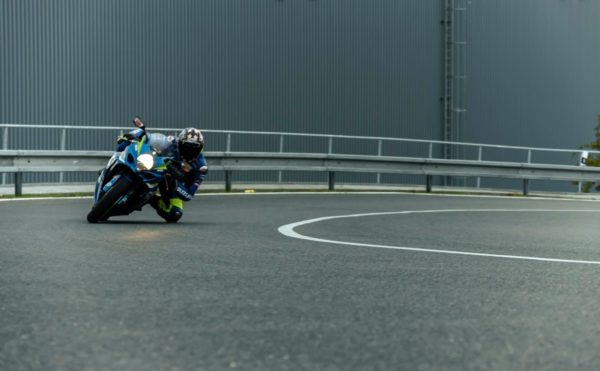“You must know the maximum lean angle before doing knee down”. I recently interviewed various professional riders, and this is what they say about the lean motorcycle angle.
Motorcycle lean angle is the maximum angle in which you can lean your motorcycle during knee down. There’s no specific lean angle for motorbikes, as lean angle depends upon your tire and track conditions. But experts believe that 55-60 degree is the maximum lean angle you can take while doing the knee down.
Let’s look at what it means for you and what you can do about it. While writing this post, I leave no stone unturned so you can get essential knowledge about lean angles.
Table of Contents
What is a Motorcycle Lean Angle?
If you’re a professional racer, you must know about lean motorcycle angle for knee down. Because a lean motorcycle angle helps to keep you safe while doing knee down.
Motorcycle lean angle is the maximum angle at which you can lean your bike safely.
According to some experts and professional riders, the maximum lean angle is highly dependent on the motorbike you’re riding, the track on which you’re riding, and tire pressure.
For example, if you’re riding a street motorbike, the lean angle can be 50 degrees. On the other hand, if you’re riding supersport, the maximum lean angle will be around 55 degrees.
Not to mention, the above example excludes tire and road track conditions. Your lean angle will decrease aggressively if your tire pressure is low.
And that’s why experts always recommend checking tire and track conditions.
How to Identify a Motorcycle Lean Angle?
Knowing the accurate motorcycle angle is crucial for any professional rider, but have you wondered how to identify a perfect lean angle for your motorbike?
To identify the perfect lean angle, you just need to do a knee down and notice the angle at which your motorbike peg is starting to touch the track. Don’t forget to check the tire and track condition before identifying the perfect lean angle, as it impacts highly on lean angle.
Believe me, identifying your lean motorbike angle isn’t rocket science, and you just need to do a simple knee down.
Disclaimer: Beginners, please don’t even try to do the knee down without proper guidance.
Also, read my previous post where I’ve discussed what is motorcycle knee down. Click here to read.
How to do a Motorcycle Knee Down?
For identifying the lean angle, you need to do motorcycle knee down. And here are some steps through which you can do motorcycle knee down easily.
Disclaimer: A motorcycle knee down can be extremely dangerous for anyone, and that’s why I highly recommend wearing all motorbike gear. And stay away from the motorcycle with knees down if you’re a beginner.
Here are the steps below: do this in the professional racer guidance only.
| How to do motorcycle knee down | Details |
| Grab the correct position. | Ensure that your knee is pointing outwards while gripping the motorcycle tank with your thigh, and position one buttock on the motorcycle seat. |
| Stay hanging off. | Aadopting a regular seated position solely to relax your hamstrings and thighs is futile. Only assume a standing position when the road ahead is straight and clear. |
| Focus on the throttle. | In urban riding, it is typical for riders to enter a curve with the throttle open. However, on the track, it is essential to avoid using the open throttle while negotiating sharp turns. |
| Focus on gears. | Adopting a regular seated position solely to relax your hamstrings and thighs is futile. Only assume a standing position when the road ahead is straight and clear. |
Grab the Correct Position:
Prior to attempting a knee-down maneuver, it is crucial to understand and adopt the correct position.
Ensure that your knee is pointing outwards while gripping the motorcycle tank with your thigh, and position one buttock on the motorcycle seat.
Lean your upper body towards the motorcycle tank, while keeping your inner arm bent and your outer arm straight.
The position of your legs plays a pivotal role that should not be overlooked. Place your inner leg on its toes, while your outer leg rests on the footpeg.
Stay hanging Off:
It is common for riders to assume a standard seated position to avoid muscle tension that may arise from knee-down maneuvers.
However, adopting a regular seated position solely to relax your hamstrings and thighs is futile. Only assume a standing position when the road ahead is straight and clear.
Even professional racers seldom adopt a standard position unless they have crossed the finish line.
Resist the urge to remain seated and practice the technique of hanging off the motorcycle.
Focus on Throttle:
In urban riding, it is typical for riders to enter a curve with the throttle open. However, on the track, it is essential to avoid using the open throttle while negotiating sharp turns.
Instead, always enter a curve with a closed throttle and gradually open it once you have a clear straight path ahead.
Using the throttle openly during sharp turns can destabilize the motorcycle and lead to serious accidents.
Focus on Gears:
When approaching a sharp turn, it is important to close the throttle, which also implies selecting a higher gear.
By mastering the techniques mentioned above, executing a knee-down maneuver will not be an insurmountable challenge.
Remember, relying solely on a knee-down position will not increase your speed; it is essential to employ the proper technique.
For a more comprehensive understanding of knee-down maneuvers, consider referring to the YouTube videos provided below.
Can Beginners Do Motorcycle Knee Down?
The knee-down maneuver on a motorbike is undeniably impressive, often attracting the attention of beginners. However, it is worth considering whether beginners are capable of performing this advanced technique.
Experts typically discourage beginners from attempting motorbike knee-downs. The reason behind this caution is that executing a knee-down maneuver requires extensive practice, and a single misstep could result in severe knee ligament injuries or fractures. Experts also stress the importance of wearing appropriate riding gear, such as riding pants and knee sliders, when practicing knee-down techniques.
Due to the inherent risks involved, motorbike knee-downs are not considered suitable for beginners. Consequently, instructors in the Motorcycle Safety Foundation Course (MSF) refrain from teaching knee-downs to novice riders.
If you find yourself in the beginner category, it is strongly advised to refrain from attempting knee-down maneuvers.
Why You Shouldn’t Depend on Lean Angles?
So far, you understand what should be the perfect lean angle and how you can identify one. But have you wondered why experts do not recommend depending on a lean angle?
Experts don’t recommend depending on the motorbike’s lean angle completely when doing knee down. It’s because a motorcycle’s lean angle is highly influenced by the tire pressure, track condition, and motorbike model you’re riding. Even one factor can affect your motorbike angle highly.
For example, if you’re riding a sportbike in good tire and track condition, the lean angle will be approximately 55 degrees.
On the other hand, if you’re riding the same model with the same track condition but with low tire pressure, your lean angle will be much lesser than the previous one.
And that’s why experts always recommend not depending on a motorcycle’s lean angle.
How Does Lean Angle Depend on a Motorbike Model?
So far, you understand what a lean motorbike angle is, and you might think that the lean angle is highly influenced by the motorbike model.
Motorbike lean angle is highly influenced by motorbike models because every motorbike has a different peg and leg position. It means no two motorbike models can lean at the same lean angle because of the peg position. For example, the peg position of a stock road motorbike is much lower than a sportbike.
And that’s why experts always recommend not to believe the crap advice saying all motorbike models have the same lean angle.
Also, low-pressure tires can’t distribute the motorbike weight properly; thus, you’ve to be careful when selecting motorbike tires.
Just like tire pressure, track position and corner also impact the motorbike’s lean angle highly.
Frequently Asked Questions:
On which factors motorbike lean angle depends?
According to some experts and professional riders, the maximum lean angle is highly dependent on the motorbike you’re riding, the track on which you’re riding, and tire pressure.
How can you identify a motorbike lean angle?
To identify the perfect lean angle, you just need to do a knee down and notice the angle at which your motorbike peg is starting to touch the track.
How to grab the perfect position for a motorbike lean angle?
Before doing knee down, your knee should point outwards while your thigh should grip your motorbike tank, and your one bum should be one motorbike seat.
Why shouldn’t beginners do motorbike lean angle?
Experts usually don’t recommend doing such things for beginners. It’s because doing a motorbike knee down takes a lot of practice, and any mistake could rupture knee ligaments or break knee joints.
Why it’s better to not depend on a motorbike lean angle?
It’s because a motorcycle’s lean angle is highly influenced by the tire pressure, track condition, and motorbike model you’re riding. Even one factor can affect your motorbike angle highly.
Final Verdict:
What is a motorcycle lean angle? Motorcycle lean angle is the maximum angle in which you can lean your motorcycle during knee down.
There’s no specific lean angle for motorbikes, as lean angle depends upon your tire and track conditions. But experts believe that 55-60 is the maximum motorbike lean angle you can take while doing the knee down.
Your motorbike model highly influenced your motorbike’s lean angle because of the peg position. Two motorbike models can’t have the exact peg location; thus, their lean angle differs significantly.
Also, don’t forget to check tire pressure as low tire pressure can’t distribute the weight, reducing the lean angle.
John, this side! My passion for motorbikes started when I was 12. I experienced many accidents and even lost some friends too. And it inspired me to create this website so that no parents in this world would lose their child while enjoying riding.


